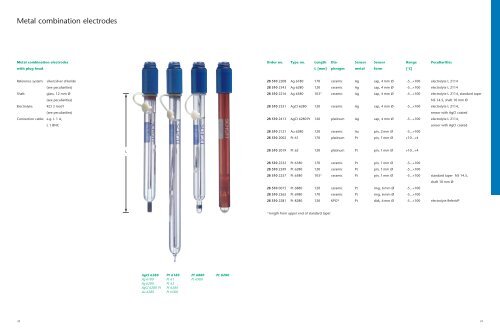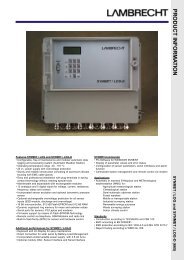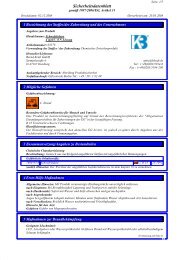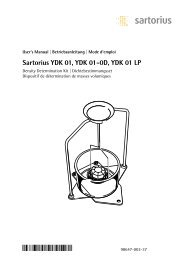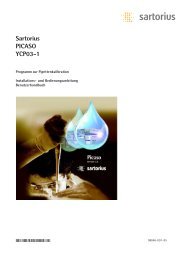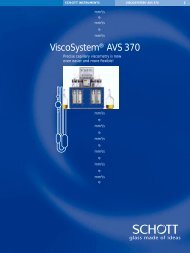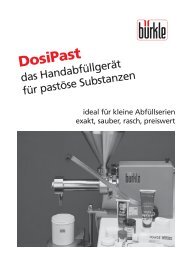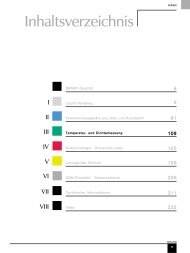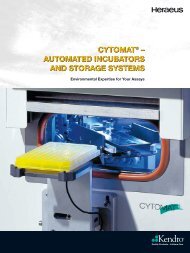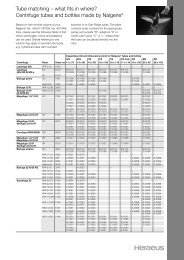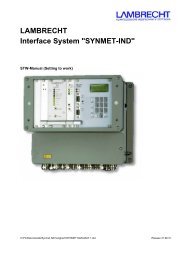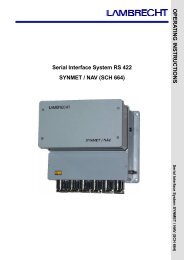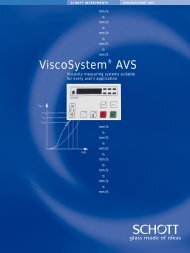Laboratory Electrodes - Windaus
Laboratory Electrodes - Windaus
Laboratory Electrodes - Windaus
Create successful ePaper yourself
Turn your PDF publications into a flip-book with our unique Google optimized e-Paper software.
Tips and information<br />
for successful measurements<br />
Storage<br />
Redox sensors and pH sensors should be<br />
kept in the solution with which the reference<br />
electrode is also refilled (submerge up to the<br />
diaphragm). In most cases, this is KCl solution<br />
(3 mol/l, type no. L 300). Low-maintenance<br />
electrodes are also kept in KCl solution.<br />
Conductivity measuring cells, after<br />
being cleaned and rinsed-off with distilled<br />
water, can be stored in a dry location.<br />
Measuring<br />
With refillable pH sensors and redox sensors,<br />
the refilling opening must be opened in<br />
order to carry out the measurement. The<br />
sensor is then submerged in the measuring<br />
medium at least up to the diaphragm.<br />
With refillable sensors, it is important to pay<br />
attention to the filling level of the electrolyte<br />
solution (see Refilling). Between measurements,<br />
the sensor should be rinsedoff<br />
with distilled water but not wiped off.<br />
Excess droplets can be carefully sponged-off.<br />
Calibrating<br />
Since the measuring characteristics of pH<br />
sensors change with time, they must be calibrated<br />
at regular intervals using appropriate<br />
12<br />
buffer solutions. If buffer solutions from bottles<br />
are used, the bottles must be closed immediately<br />
after use. The buffer solution used<br />
should never be put back into the bottle but<br />
must be discarded instead. If very accurate<br />
calibration is necessary, we recommend<br />
DIN single use ampoules that always contain<br />
fresh high precision solutions. Redox sensors<br />
are not calibrated. Their proper function<br />
can be checked using the appropriate test<br />
solutions. For conductivity measuring cells,<br />
the cell constant should be checked and<br />
adjusted at regular intervals with test solutions.<br />
Greater variations in the cell constants<br />
are an indication of soiling or damage.<br />
Refilling<br />
Refillable pH sensors and redox sensors are<br />
refilled with electrolyte solution so that the<br />
filling level of the electrolyte solution is at<br />
least 5 cm above the level of the measuring<br />
medium. With BlueLine electrodes, the easi-<br />
est way to carry out the refilling operation<br />
is to pump the electrolyte solution into the<br />
electrodes using a small dispensing bottle.<br />
Cleaning<br />
A soiled reference electrode should be emptied,<br />
rinsed with electrolyte solution and<br />
then filled again with electrolyte solution.<br />
In case of soiling of the glass membrane or<br />
diaphragm, it should be cleaned in order to<br />
maintain the measuring function. Depending<br />
on the degree of soiling, only the glass<br />
membrane or the glass membrane with<br />
the diaphragm is submerged in the cleaning<br />
solution. Cleaning agents that may have<br />
penetrated into the electrode must not be<br />
allowed to get into the reference system; if<br />
required, the reference electrode must be<br />
rinsed-off with distilled water and electrolyte<br />
solution. Depending on the degree of soiling,<br />
the methods mentioned below are recommended.<br />
After being cleaned, the sensor should be<br />
rinsed-off with distilled water, conditioned<br />
in electrolyte solution for 1 hour or longer<br />
and then recalibrated prior to performing<br />
any further measurements.<br />
Soiling Treatment Info<br />
inorganic adhering substances several minutes, e.g. with HCl improved cleaning action with<br />
0.1 mol/l or NaOH 0.1 mol/l warm solutions (40–50 °C)<br />
organic substances (oil, grease, etc.) rinse off with suitable organic solvent for plastic shaft electrodes, take chemical<br />
(e.g.ethanol) or tenside solution resistance into account. Sensor can also be<br />
wiped of with a soft, moistened cloth.<br />
proteins approx. 1 hour with pepsin/HCl solution<br />
(type no. L 510)<br />
sulphides (on ceramic diaphragm) with thiourea/HCl solution cause: reaction of electrolyte with<br />
(7.5 % in HCl 0.1 mol/l) up to discoloration measuring solution.<br />
remedy: electrodes with platinum<br />
diaphragm and Ag + -free electrolyte<br />
Sensors for all applications<br />
Many different application conditions require the use of appropriate, specifically designed pH sensors.<br />
For your application, you can select the electrode with the optimal pH glass and diaphragm.<br />
pH glasses<br />
Schott electrodes are manufactured with various pH glasses.<br />
These have been optimised for your application and offer a<br />
high degree of measuring accuracy and reliability. Select the<br />
pH glass for your application:<br />
pH glass<br />
N-glass: for general applications across the whole pH range<br />
A-glass: with short response time in drinking water, service<br />
water and waste water; for general application and<br />
in media with low ion content<br />
L-glass: for low temperatures and general applications<br />
H-glass: for high temperatures, in acid and alkaline range,<br />
even with high sodium-ion concentrations<br />
S-glass: in hot alkaline media with good reproducibility and<br />
short response time<br />
Diaphragm<br />
An important factor for a reliable and reproducible pH measurement<br />
is the selection of an electrode with a suitable<br />
diaphragm:<br />
Diaphragm<br />
Platinum diaphragm: universal, shows its strength especially<br />
with solutions containing<br />
solids and at extreme pH values and<br />
temperatures. It is ideal for titrations<br />
and very insensitive to stirring.<br />
Ceramic diaphragm: robust for general applications, low<br />
electrolyte outflow rate.<br />
Ground joint preferred for liquids with high solids<br />
diaphragm: contents, easy to clean.<br />
Fibre diaphragm: for robust, minimum-maintenance<br />
electrodes. Preferred for general<br />
applications and field measurments.<br />
KPG ® annular gap on minimum-maintenance<br />
diaphragm: electrodes, with symmetric annular<br />
gap, insensitive to soiling.<br />
13


